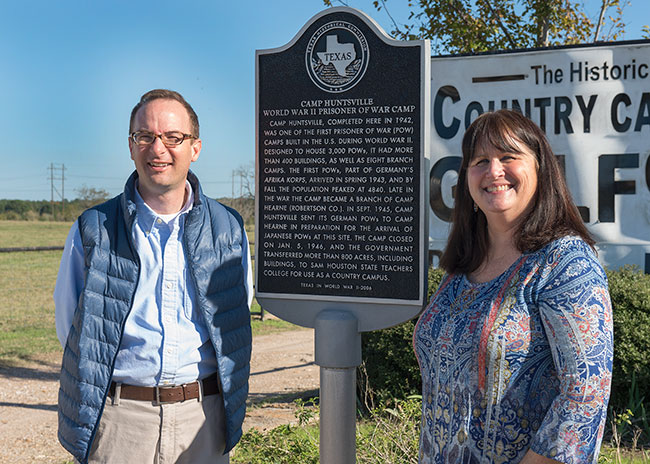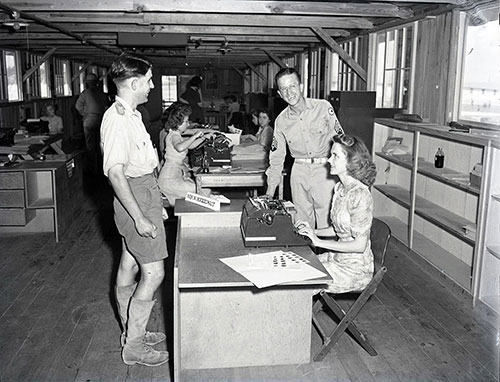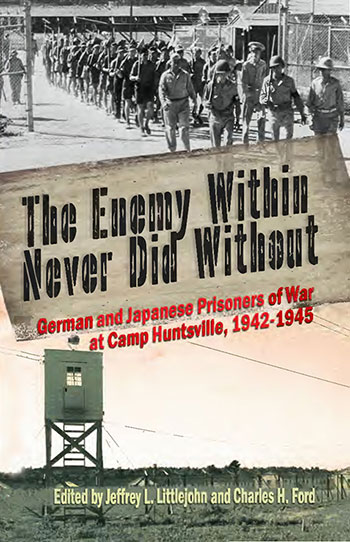Today@Sam Article
Grad Students Explore Huntsville's Role In World War II Via POW Camp
Nov. 30, 2015
SHSU Media Contact: Chelsea Keller
 |
| Associate history professor Jeffrey Littlejohn and history graduate program alumna Carolyn Carroll stand beside the sign that reveals the history of Camp Huntsville, which served as a POW camp during World War II. Located 10 miles northeast of Huntsville, the land was later acquired by SHSU for Country Campus and is now used for the Country Campus Golf Course and the SHSU Observatory. —Photo by Brian Blalock |
Shortly after the United States entered World War II in December 1941, the U.S. Army Corps of Engineers issued a report recommending that the nation’s first permanent prisoner of war camp be constructed near Huntsville.
Over the course of the next 16 months, the Houston-based Fretz Construction Company built “Camp Huntsville” to accommodate roughly 4,800 prisoners from battlefields in Europe, Africa, and Asia.
By April 1943, construction at the site was complete and hundreds of German troops from the Afrika Korps began to arrive at the camp.
Located about 10 miles northeast of Huntsville on Highway 19, Camp Huntsville sat on land that is now known as Country Campus Golf Course.
When Jeffery L. Littlejohn, associate history professor at Sam Houston State University, first learned about the POW camp from Donna Coffen, a local member of the Walker County Historical Commission, he found the story fascinating.
“Driving out to Country Campus, where the camp used to be, to find that the local site had been destroyed over time was heart-breaking. This history has been erased,” Littlejohn said.
In the spring of 2012, Littlejohn decided to focus a graduate seminar on Camp Huntsville. He and 10 graduate students sifted through hundreds of historical documents from the National Archives at College Park, Maryland, as well as stories from national newspapers and oral interviews housed in local libraries. The end result was a book titled, “The Enemy Within Never Did Without: German and Japanese Prisoners of War at Camp Huntsville, 1942-1945.”
 |
| Donna Coffen's mother, Nina Mickelwait Collier (above, at the typewriter), served as a civilian-processing assistant at the camp during the war. Coffen, who is a member of the Walker County Historical Commission, introduce Littlejohn to the history of Country Campus and Camp Huntsville. —Submitted photo |
“A project like this takes time,” Littlejohn said. “We spent three years working on the book, but this is something I enjoy. You just have to have the documents; having all this information allowed us to tell the story of this World War II POW camp.”
Before the graduate course started, Littlejohn had created a table of contents for the book. The students were then paired up and, as part of the course, were required to write a draft for the chapter they were assigned.
Each student brought something different to the project.
“Having been in the U.S. Army for 12 years, a defense contractor for four years and being a veteran, I brought a unique perspective to the project,” graduate student Bradley Trefz said. “My own military experience gave me an advantage in wading through the primary documents, and I was able to share information about the guards at the POW camp and the different soldiers stationed there.”
With the countless pages of historical documents, there were many pieces to connect.
“When we put together reports with other sources, we opened up a window into a host of Nazi problems at the camp during its early years,” Trefz said. “That was like fitting together pieces of a jigsaw puzzle, where we had no picture to work from. When it all came together it was like an ‘aha’ moment.”
Along with the historical documents, Littlejohn and his students were able to track down people with personal accounts of what the POW camp was like.
Carolyn Carroll, who now is a lecturer for the history department, was one of the few students who was local during the semester (the program has a large online population) and was responsible for a lot of the legwork. But more importantly, she got the chance to speak with local citizens.
“I was able to give a personal touch to the stories so local citizens could read the book and remember things or people from that time,” Carroll said. “I was also lucky enough to speak with daughter of a prisoner of war. The family, from Chicago, contacted the Huntsville Public Library looking for more information on her father’s time at Camp Huntsville.
 “I was so excited and honored to hear her father’s story about being at Camp Huntsville. It was just one of the many personal accounts we have in the book.”
“I was so excited and honored to hear her father’s story about being at Camp Huntsville. It was just one of the many personal accounts we have in the book.”
The book is filled with personal accounts from people as far away as New Jersey and as close as Spring, including those not only from prisoners but also from guards.
“Titus Fields, who is still living in Spring, came to our class and told us about his experience from working as a guard at Camp Huntsville. Even though he was only 17 or 18, he remembered much of what happened,” Littlejohn said.
Fields recalled the high quality of the food service at the camp, telling the students that the prisoners, “ate exactly what [the guards] ate, only it was better. We had model prisoners, and they had the best to eat.”
In the summer 1945, following the defeat of Germany, the United States began to repatriate the German POWs at Camp Huntsville. That September, 150 Japanese prisoners were transferred to the local camp, where the U.S. government operated the nation’s only re-education program for Japanese POWs. Professors from SHSU participated in the program, teaching POWs about American democracy, civil liberties, and constitutional government.
The final chapter of the book focuses on what happened to the camp after the war. In 1946, Harmon Lowman, the president of Sam Houston State Teaching College, purchased the camp from the U.S. government for $1. The former prison barracks were converted to student housing and the larger building served as academic classrooms for returning soldiers. Renamed Country Campus, the former POW camp became a vital part of SHSU’s operations for a decade.
“The Enemy Within Never Did Without: German and Japanese Prisoners of War at Camp Huntsville, 1942-1945” is available through the Texas Review Press website, on Amazon and at the Sam Houston Statue.
- END -
This page maintained by SHSU's Communications Office:
Director of Content Communications: Emily Binetti
Communications Manager: Mikah Boyd
Telephone: 936.294.1837
Communications Specialist: Campbell Atkins
Telephone: 936.294.2638
Please send comments, corrections, news tips to Today@Sam.edu
